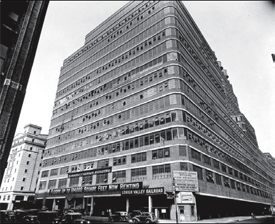1974: HELMSLEY BUYS STARRETT-LEHIGH FOR $13.5M

Starrett-Lehigh building Real estate mogul Harry Helmsley snapped up the largest manufacturing property in the city — the 2.2 million-square-foot Starrett-Lehigh Building in Chelsea — for a bargain price of $13.5 million in a foreclosure auction, 37 years ago this month.
Helmsley, president of Helmsley Spear, beat out the Chicago-based real estate investment firm that was a lender on the building and had started foreclosure proceedings. The investment firm refused to bid more than the $2.1 million mortgage it provided, paving the way for Helmsley to take control of the property at 601 West 26th Street, which was owned by Jacob Freidus.
The $13.5 million price tag included Helmsley’s payment of $2.2 million in cash, the assumption of $10.8 million in debt, plus a $500,000 loan Helmsley provide on the building that he forgave.
In 1944, the 30-year-old Freidus had purchased the property for an undisclosed sum. But by the time Helmsley came in, manufacturing was on the decline and the structure was just 60 percent occupied, with rental rates at about $1.20 per square foot.
Earlier this year, Scott Rechler’s RXR Realty agreed to buy the 1932 building — which occupies the entire block from 26th to 27th streets and from 11th to 12th avenues — for $900 million.
1944: ALICE AUSTEN EVICTION BLOCKED AT 1690 HOME

Alice Austen The federal government stepped in to stop the eviction of the then-unknown artist Alice Austen from a pre-Revolutionary War house in Staten Island, 67 years ago this month.
The government revoked the order to remove the 78-year-old and nearly penniless Austen from the Victorian Gothic, two-story 1690 house at 2 Hylan Boulevard, just days before she was to be thrown out.
The 1944 eviction attempt highlighted the sharp decline in fortune for Austen, who had lived in the house since she was an infant. In 1918, Austen, who was living in the house with her longtime partner, Gertrude Tate, turned down offers to sell the property for the significant sum of $100,000 to real estate broker and operator Joseph P. Day. Then, nearly two decades later (in the mid-1930s), Austen lost ownership of the home, known as Clear Comfort, in a foreclosure auction, though she continued living there as a tenant.
In August 1944, Austen’s landlord, Grace Mandia, was just days away from taking control of the property, but got stymied when it was discovered that she misrepresented her intentions and was planning on selling it. Because of the tight housing market during World War II, a landlord could not legally throw out a tenant unless the owner intended to live there. In addition, the New York Times reported that year that Mandia’s father, a bar owner, had considered opening a tavern there.
Austen moved out in 1945 and died in 1952. The house is now a museum.
1910: 17TH-CENTURY DUTCH, ENGLISH RECORDS LOST
Nearly two dozen of the city’s oldest real estate transfer books documenting deeds and mortgages from as early as 1686 were lost 101 years ago this month. City officials speculated that some of the 23 volumes, known as “libers,” disappeared when the old Hall of Records in City Hall Park was torn down in 1903 and a new one was built. But since the books had not been kept securely, they could have been taken at any time in the preceding years.
The most valuable book, known as Liber B, had historically valuable records in both Dutch and English and included transcripts of conveyances occurring just after New York Governor Thomas Dongan issued the so-called Dongan Charter in 1686. The charter gave to the City of New York, which at that time was only the island of Manhattan, all “waste, vacant, unpatented and unappropriated lands.”
Other volumes from the 17th and 18th centuries that went missing included the original records of the division of large farm tracts in Manhattan like the Bogardus farm, later controlled by the powerful church-affiliated Trinity Corporation.
Despite the loss, there was no confusion in title, because copies and redundant records had been compiled for years in Albany.
Compiled by Adam Pincus
